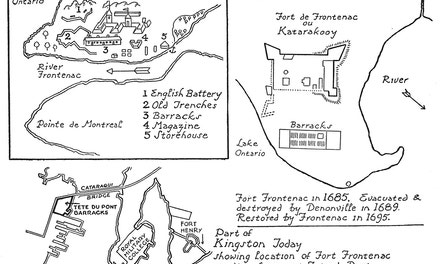Frontenac Joins in the War Dance
Library and Archives Canada (Watercolour)
Library and Archives Canada (Pen and Ink)
Exhibition History
- 1918 - Exhibition title: Tableaux, Esquisses, Dessins, Aquarelles, Gravures, Etc exhibés par le Bureau des Archives Féderales. Curators: National Archives of Canada (Bureau des Archives Fédérales), Palais Central de l'Exposition Provinciale, Quebec; 1918, cat. no.: no. 104.
Remarks
C.W. Jefferys' notes about this picture in Dramatic Episodes in Canada's Story
Under Frontenac's rule, French explorers pushed into the interior of the continent, built forts and trading posts, and extended their influence over the Indians of the North and West, while the Iroquois, awed by the great governor, kept the peace. But Frontenac's imperious and fiery temper involved him in continual quarrels with the clergy, the members of his council, and the Intendant, or business administrator of the colony, until the king, tired of the discord, recalled him in 1682.
The governors who succeeded him were failures, and evil times came upon Canada. The Iroquois grew jealous of the increasing control of the West by the French, which took the fur trade out of their hands. Encouraged by the English traders of New York, they attacked and robbed the Indian allies of the French. Denonville, the French governor, treacherously captured a number of friendly Iroquois and sent them to serve as galley-slaves in France. The Iroquois, furious at this outrage, took a fearful revenge. On the night of the 4th of August, 1689, in the midst of a violent storm, fifteen hundred warriors fell upon the village of Lachine, near Montreal, burned the houses, and massacred the inhabitants, men, women and children. Only a few of the fugitives escaped. For weeks the Iroquois ravaged the country, capturing and killing the settlers, and spreading terror throughout the colony.
To add to the peril of Canada, war broke out between England and France. The English rebelled against James II, drove him from his kingdom and called his son-in-law, William of Orange, to the throne. Louis XIV supported the cause of the exiled James, who, like himself, was a devout Roman Catholic. War was declared, and Canada, already harassed by the Iroquois raid, was threatened with attack by the neighbouring English colonies, which greatly exceeded the French in wealth and population.
A strong hand was needed to save Canada. The king turned to Frontenac, who, with all his faults, had proved himself a firm and capable governor. He sent him out to Canada again. Frontenac was now in his seventieth year, but his vigour was unabated, and he had lost none of his audacity and self-confidence. His return brought hope and courage to the distressed colony, and the old soldier at once set himself to prepare for the defence of Canada, and also to carry the war into the enemy's country.
It was necessary above all, to restore the confidence of the western Indians. Disgusted by the weakness of the French governors, and impressed by the success of the Iroquois, they were wavering in their alliance, and there was grave danger that they might go over to the side of the English. Frontenac sent word to them, telling them that he had returned, and would protect them if they remained true to their French friends. The Indians had not forgotten the great "Onontio," as they called the governor of Canada, and Frontenac's message won them over.
In the summer of 1690, a great flotilla of canoes, manned by hundreds of friendly Indians and laden with an enormous cargo of valuable furs, came down the Ottawa from the upper lakes to trade with the French at Montreal. They landed near the town, drew up their canoes, and pitched their tepees on the shore. Before the trading began, a grand council was held. Frontenac welcomed them, smoked the peace pipe, and listened to their orators. Then he arose and made a stirring speech, declaring that he would fight the Iroquois until they begged for peace, and exhorting his Indian allies to stand firm for the French and join in the war. Then, seizing a tomahawk and waving it in the air, the courtly and dignified old governor sang the war song, and, whooping and stamping, led the savages in the war dance around the camp fire. The Indians were thrilled with enthusiasm and promised war to the death. It was a strange performance on the part of the haughty nobleman, accustomed to the dignified etiquette of the society of his time; but Frontenac knew how to adapt himself to his company, and understood the Indian character. Like Champlain, and many other Frenchmen in Canada, he was as much at home in the wilderness and among savages as at Versailles with the king and his courtiers.
Published References
- Jefferys, Charles W. 1934 Canada's Past in Pictures, p. 59
- Jefferys, Charles W. 1942 The Picture Gallery of Canadian History Volume 1, p.160





Frontenac Joins in the War Dance